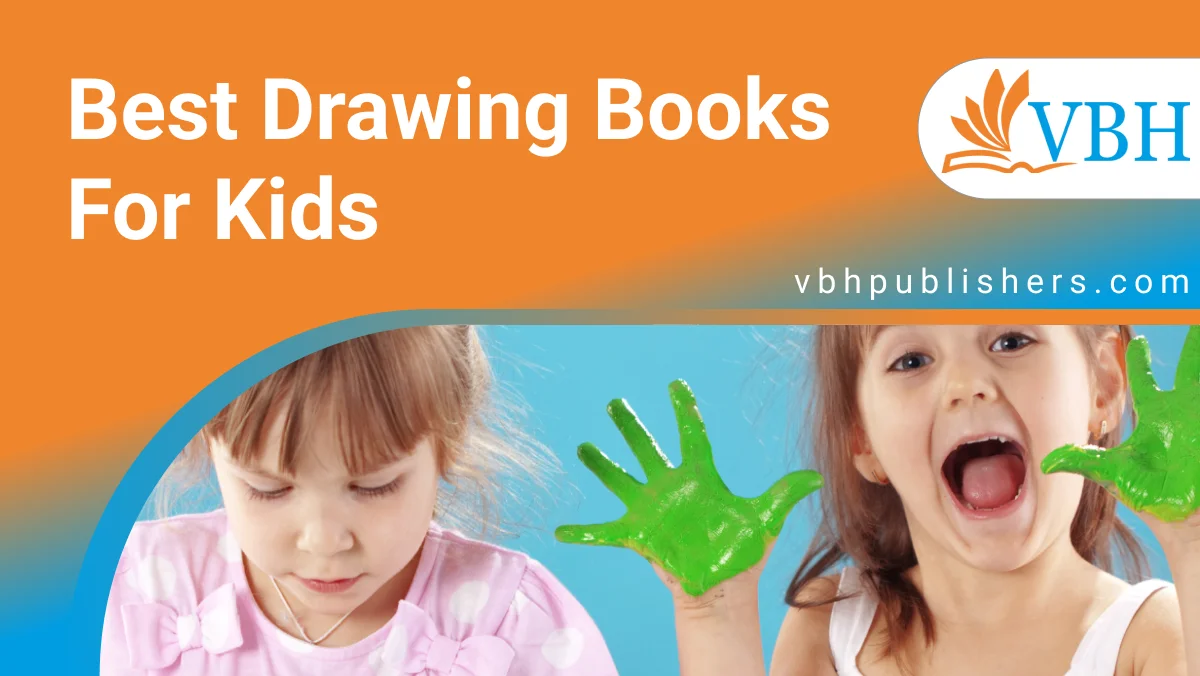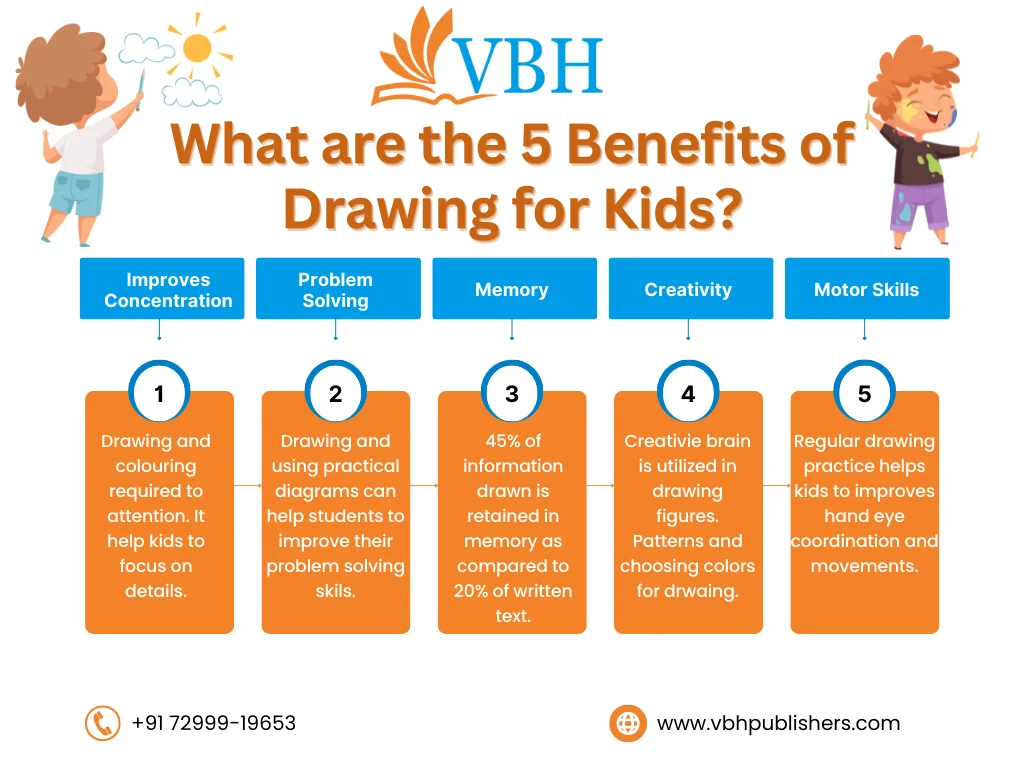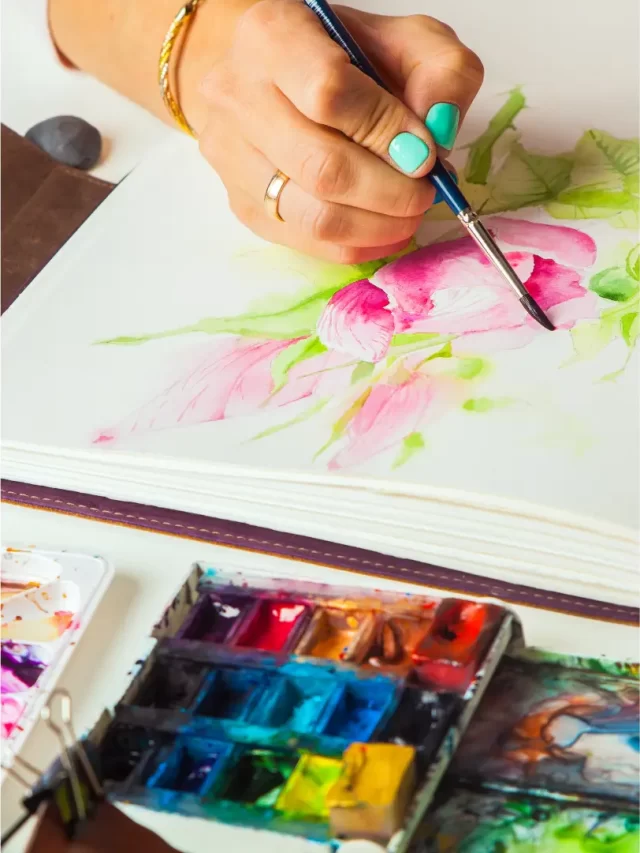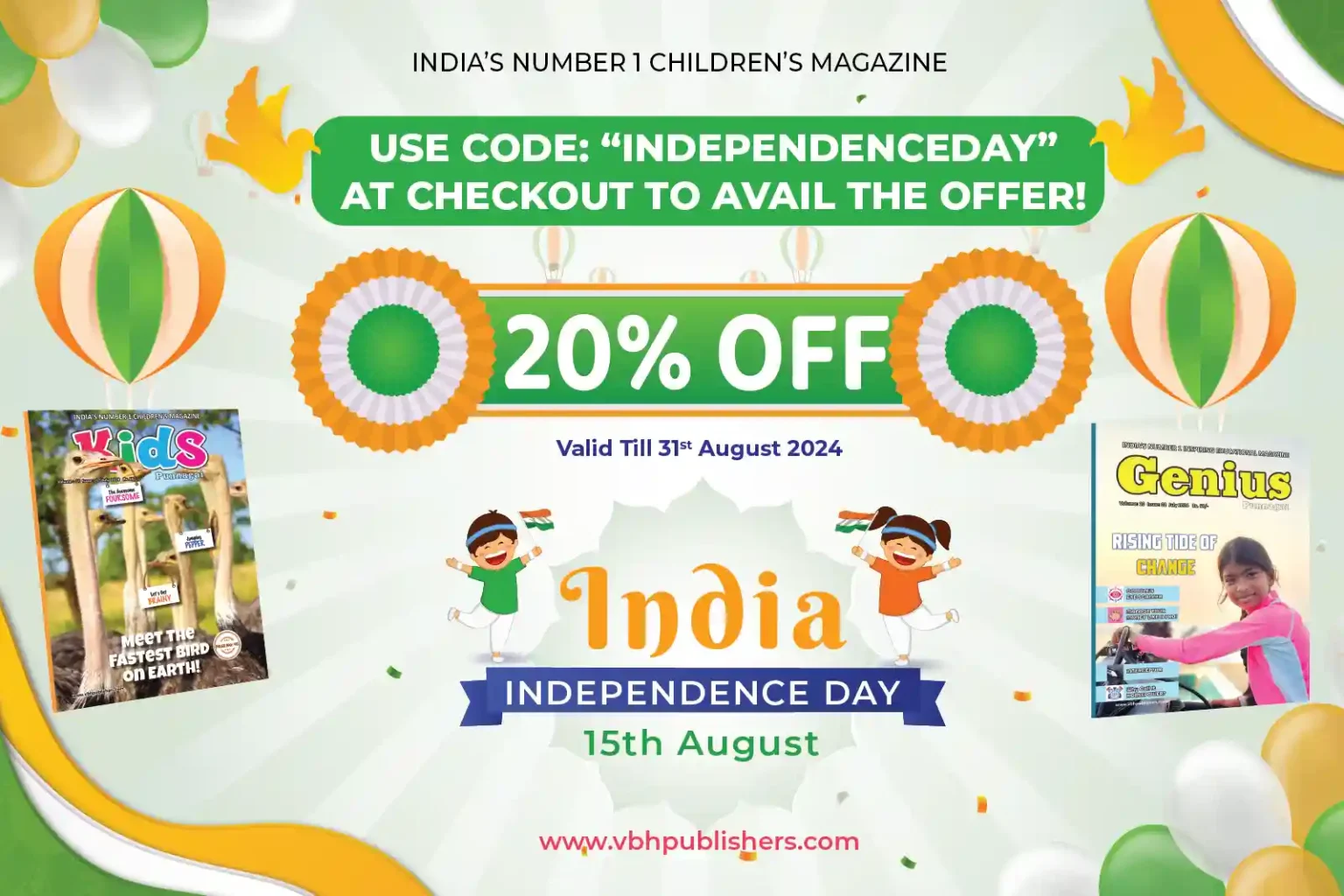UKG Drawing Book
- Last Updated:

UKG Drawing books for nursery class kids is a very effective tool to expand children’s creativity. In this article, we will discuss how nursery drawing books enhance the creativity of child development and how it stimulates them. Drawing is an outstanding tool to foster creativity and imagination among children.
Enhancing creativity at an early age through drawing is very interesting and important also because at this age children’s minds are very sharp and they are eager to grasp things more quickly.
Salient Features of Early Skills
This nursery drawing book has several salient features that make it an excellent resource for young learners:
- Age-Appropriate Content: The book’s contents are specifically crafted to cater to the educational requirements of children belonging to the nursery age group. The exercises and activities are intentionally kept uncomplicated but interesting with the intention of engaging children with short attention spans and developing their motor skills.
- Colorful Illustrations: The LKG colouring book is filled with bright and colorful illustrations that appeal to young learners. The images are simple and easy to understand, making it easier for children to follow the instructions and complete the exercises.
- Variety of Activities: The book offers a wide range of activities to keep the children engaged and interested. The exercises include tracing, drawing, coloring, and connecting the dots, among others. These activities help children develop their hand-eye coordination, fine motor skills, and creativity.
- Step-by-Step Instructions: The book provides step-by-step instructions for each activity, making it easier for children to understand and complete the exercises on their own.
- Engaging Themes: The book has themes that are relevant and interesting to young children, such as animals, fruits, and vegetables. These themes help children connect the activities to real-life objects making the learning process more meaningful.
- Focus on Skill Development: The book emphasizes the development of specific skills such as hand-eye coordination, fine motor skills, and creativity. The activities are designed to help children develop these skills in a fun and engaging way.

Best Nursery Book Ideas
Here are some of the best nursery book ideas:
- Alphabet Books: Introduce the alphabet through colorful illustrations and simple words corresponding to each letter. These nursery drawing books help children develop letter recognition and phonemic awareness.
- Counting Books: Teach numbers and counting using vibrant images and relatable objects. Counting books allow children to grasp numerical concepts and develop basic mathematical skills.
- Nursery Rhyme Collections: Compile a collection of popular nursery rhymes like “Twinkle, Twinkle, Little Star” and “Humpty Dumpty.” Rhymes foster language development, rhythm, and memory skills.
- Animal Books: Children are fascinated by animals. Create books that showcase different animals, their habitats, and sounds. This encourages vocabulary development and nurtures a love for nature.
- Shape and Color Books: Introduce shapes and colors for the best nursery drawing books that encourage children to identify and match shapes or name colors. This promotes visual discrimination and cognitive skills.
- Storybooks with Moral Lessons: Choose age-appropriate stories with simple narratives and relatable characters that teach valuable life lessons such as kindness, sharing, and honesty.
- Touch-and-Feel Books: Incorporate tactile elements like different textures or flaps to engage children’s senses. These books enhance sensory exploration and cognitive development.
- Interactive Books: Include books with movable parts, lift-the-flap features, or sound buttons. Interactive books foster engagement, fine motor skills, and cognitive development.
10 Benefits of UKG Drawing Book for Your Child’s Development
Here are 10 ways to illustrate the benefits of drawing books and how they can be useful:
- Creativity: Nursery drawing books can spark your child’s imagination and creativity, allowing them to express their thoughts and ideas in a visual way.
- Fine Motor Skills: Drawing involves small and precise movements of the hand, which can help improve your child’s fine motor skills and hand-eye coordination.
- Concentration: Drawing requires focus and concentration, which can help improve your child’s attention span and ability to concentrate on a task.
- Problem-Solving Skills: LKG colouring book involves making decisions about colors, shapes, and composition, which can help develop your child’s problem-solving skills and decision-making abilities.
- Language Development: Drawing can be a way for your child to tell stories and communicate ideas, helping to develop their language and communication skills.
- Self-Expression: Using nursery drawing books allows your child to express their emotions and feelings in a safe and creative way.
- Confidence: Creating something with their own hands can help your child develop a sense of achievement and build their confidence.
- Observation Skills: Drawing requires observation and attention to detail, which can help improve your child’s observational skills and ability to notice small details.
- Memory: Drawing can help improve your child’s memory by requiring them to remember details and recall information.
- Relaxation: Drawing can be a relaxing and enjoyable activity for your child, helping to reduce stress and improve their overall well-being.
Choosing the Right Drawing Books for Your Child
Choosing the right LKG drawing book for your child can be a challenging task. You want to find a book that will not only be engaging but also help your child develop their drawing skills. Here are some tips to help you choose the right LKG class drawing book for your child.
- Look for Books with Simple Drawings – When choosing a drawing book for LKG, look for one with simple drawings. Your child is just starting to learn how to draw, so they need to start with the basics. Simple drawings will help your child learn how to draw lines and shapes, which are the building blocks of all drawings.
- Choose Books with Age-Appropriate Themes – The theme of the drawing book for LKG is also an important factor to consider. Look for books with age-appropriate themes that your child can relate to. For LKG children, themes like animals, nature, and simple objects are great starting points. Avoid books with complex themes that might be too difficult for your child to understand.
- Check the Quality of the Paper – The quality of the paper used in the drawing book for nursery class is important. Make sure that the paper is thick enough to withstand repeated erasing and re-drawing without tearing. Also, check that the paper of the drawing book is of good quality so that the colors do not bleed through to the other side.
- Look for Books with Step-by-Step Instructions – Books with step-by-step instructions are a great way to teach your child how to draw. Look for LKG drawing books that break down each drawing into simple steps that your child can follow. This will help your child learn how to draw more complex drawings in the future.
- Consider the Size of the Book – The size of the LKG colouring book is also important. Look for a book that is the right size for your child’s hands. If the book is too big, it might be difficult for your child to hold and draw in. If the book is too small, it might be difficult for your child to see the details of the drawing.
- Check for the Use of Bright Colors – Bright and vibrant colors can make the drawing book more engaging and attractive for your child. Look for books that use bright colors to capture your child’s attention and keep them interested in drawing.
- Look for Books with Engaging Activities – Engaging activities such as coloring pages, mazes, and connect-the-dots can make the drawing book more interesting and fun for your child. Look for LKG class drawing books that incorporate these types of activities to help your child develop their creativity and hand-eye coordination.
- Consider Your Child’s Interests – When choosing an LKG drawing book, consider your child’s interests. If your child loves animals, look for books with animal-themed drawings. If your child is interested in cars, look for books with car-themed drawings. This will help keep your child interested in the drawing book and encourage them to keep drawing.
Five Ways to Use Nursery Drawing Books
- Encourage Exploration: Children have a natural curiosity and love to experiment with new things. Encourage your child to explore the nursery drawing book by providing them with different colors, textures, and materials to work with. Let them experiment with different styles and techniques and see where their imagination takes them. By giving them the freedom to explore, you can help your child develop their own unique style and approach to drawing in the pre nursery drawing book.
- Use Prompts: Sometimes, children need a little inspiration to get their creativity flowing. Provide your child with prompts or themes to draw, such as animals, nature, or their favorite storybook characters. This can help spark their imagination and give them a starting point for their drawing. As they get more comfortable with drawing, you can encourage them to come up with their own ideas and prompts.
- Provide Guidance: While it’s important to give your child the freedom to create, providing guidance can also be helpful. Offer tips and suggestions to help your child improve their skills while using the pre nursery drawing book like making them know how to draw different shapes or how to shade and blend colors. Give them positive feedback and encouragement to build their confidence and help them feel proud of their work.
- Make it Fun: Drawing should be a fun and enjoyable activity for your child. You can enhance their creativity by making it a positive and engaging experience. Try playing music or making up silly stories to go along with the drawings. You can also create a game out of the process by challenging your child to draw certain objects or characters within a certain time limit.
- Celebrate Achievements: Finally, it’s important to celebrate your child’s achievements and encourage them to keep exploring and creating. Display their drawings around the house or create a special book or portfolio to showcase their work. This can help build their confidence and inspire them to keep improving.
Benefits of Drawing for Children
Drawing is a fundamental activity that can have significant benefits for children’s development. Not only does it allow children to express themselves creatively, but it also helps them develop important cognitive and motor skills. Here are some of the many benefits of drawing for children.
Creativity and Imagination
Drawing is a powerful tool for children to express their creativity and imagination. When children draw, they have the freedom to create whatever they want, which can help them develop their imagination and think outside the box. This creativity can carry over into other areas of their lives and help them solve problems in unique ways.
Fine Motor Skills
UKG drawing books help children develop their fine motor skills. Holding a pencil or crayon and controlling its movement across paper requires small, precise movements of the fingers and hand. With practice, children can improve their dexterity and control, which can benefit them in many other areas of their lives, such as writing and playing musical instruments.
Hand-Eye Coordination
The LKG colouring book also coordinates their hand movements with their visual perception of what they are drawing. This can help them develop their spatial awareness and hand-eye coordination, which can benefit them in activities like sports, driving, and typing.
Cognitive Development
Drawing book for nursery class can also promote cognitive development in children. For example, it can help them develop their spatial reasoning skills, as they learn to represent three-dimensional objects on a two-dimensional surface. Drawing can also help children develop their memory skills, as they remember details about the objects or scenes they are drawing.
Emotional Expression
Using UKG drawing books can be a powerful tool for emotional expression. When children draw, they can express their emotions in a nonverbal way. This can be especially helpful for children who have difficulty expressing their feelings verbally. The act of drawing can aid children in comprehending challenging experiences and managing their emotions.
Confidence and Self-Esteem
Using a drawing book for nursery class can also help children develop confidence and self-esteem. When children create something they are proud of, it can give them a sense of accomplishment and boost their self-confidence. Drawing can also help children develop a positive self-image, as they learn to appreciate their own unique style and abilities.
VBH Publishers – The Best Drawing Book Publishers
VBH Publishers provide more pre-nursery drawing books, UKG drawing books, LKG drawing books, and other types of art and coloring books which include in the drawing book for nursery class. They ensure the quality of the book has good printed material for kids to make them more artistic, keep them engaged, and trigger their interest to draw, color, or paint.
The Best pre-nursery drawing books published by VBH Publishers are:
- LKG Art Book – These drawing books are from the Bumblebee series which have beautiful pictures where the kids have to make it colorful by using their own style of coloring.
- Pre-KG-Colouring Book – This also belongs to the Bumblebee series which illustrates how to draw and color each picture neatly. This can be useful for your child when they are at home, daycare, or at school as it keeps them engaged.
- UKG Art Book – This UKG drawing book from the Bumblebee series is specially designed for the senior kindergarten and has numerous developmental benefits where practical knowledge has to be applied to your child’s artwork.
Conclusion
To summarize, if you want your little one to become a drawing artist at an early age, then check with VBH Publishers because they have a vast collection of UKG drawing books for your kids to trigger their emotional and cognitive skills besides keeping them highly engaged and enhancing their creative skills.
Also, Read The Best Fun Magazine for Kids in India.
Frequently Asked Questions
Teaching drawing to children for UKG drawing book can be a fun and rewarding experience. Here are some tips to get started:
- Encourage experimentation: Give children the freedom to experiment with different materials and techniques.
- Start with the basics: Begin with simple shapes and lines, and teach children how to create basic forms and structures. From there, you can build on more complex concepts and techniques.
- Use examples: Show children examples of different styles of illustrations, such as realistic, cartoon, or abstract. This can help them to develop their own unique style and ideas.
- Practice regularly: Encourage children to practice drawing regularly and set aside time for them to explore their creativity and improve their skills.
There are many different types of UKG drawing book, but some of the most common include:
- Realistic drawing: A type of drawing that aims to create a lifelike representation of a subject, such as a portrait or still life.
- Cartoon drawing: A type of drawing that uses exaggerated features and simplified forms to create humorous or stylized illustrations.
- Abstract drawing: A type of drawing that focuses on shapes, lines, and colors rather than representing recognizable objects or scenes.
For beginner UKG drawing book are just simple sketches with clear outlines and minimal shading are often the most effective. This can help children to focus on the basic shapes and forms of the illustration without getting overwhelmed by complex details. Illustrations with bright colors and bold lines can also be engaging for young readers. It’s important to remember that the most important factor is that the illustrations capture the essence of the story and help to bring it to life for the reader.



